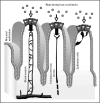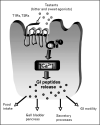Enteroendocrine cells: a site of 'taste' in gastrointestinal chemosensing
- PMID: 18185066
- PMCID: PMC2943060
- DOI: 10.1097/MED.0b013e3282f43a73
Enteroendocrine cells: a site of 'taste' in gastrointestinal chemosensing
Abstract
Purpose of review: This review discusses the role of enteroendocrine cells of the gastrointestinal tract as chemoreceptors that sense lumen contents and induce changes in gastrointestinal function and food intake through the release of signaling substances acting on a variety of targets locally or at a distance.
Recent findings: Recent evidence supports the concept that chemosensing in the gut involves G protein-coupled receptors and effectors that are known to mediate gustatory signals in the oral cavity. These include sweet-taste and bitter-taste receptors, and their associated G proteins, which are expressed in the gastrointestinal mucosa, including selected populations of enteroendocrine cells. In addition, taste receptor agonists elicit a secretory response in enteroendocrine cells in vitro and in animals in vivo, and induce neuronal activation.
Summary: Taste-signaling molecules expressed in the gastrointestinal mucosa might participate in the functional detection of nutrients and harmful substances in the lumen and prepare the gut to absorb them or initiate a protective response. They might also participate in the control of food intake through the activation of gut-brain neural pathways. These findings provide a new dimension to unraveling the regulatory circuits initiated by luminal contents of the gastrointestinal tract.
Figures


References
-
- Buchan AM. Nutrient tasting and signaling mechanisms in the gut. III. Endocrine cell recognition of luminal nutrients. Am J Physiol. 1999;277:G1103–G1107. - PubMed
-
- Dockray GJ. Luminal sensing in the gut: an overview. J Physiol Pharmacol. 2003;54(Suppl 4):9–17. - PubMed
-
- Hofer D, Asan E, Drenckhahn D. Chemosensory perception in the gut. News Physiol Sci. 1999;14:18–23. - PubMed
-
- Furness JB, Kunze WA, Clerc N. Nutrient tasting and signaling mechanisms in the gut. II. The intestine as a sensory organ: neural, endocrine, and immune responses. Am J Physiol. 1999;277:G922–G928. - PubMed
-
- Rehfeld JF. The new biology of gastrointestinal hormones. Physiol Rev. 1998;78:1087–1108. - PubMed
Publication types
MeSH terms
Substances
Grants and funding
LinkOut - more resources
Full Text Sources
Other Literature Sources
Research Materials

